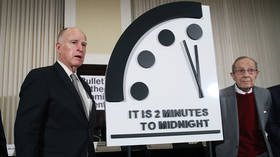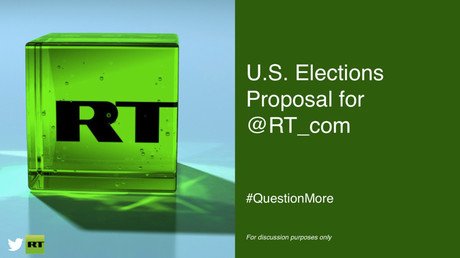‘The new abnormal’: Doomsday clock holds steady at two minutes to midnight

The United States' decisions to abandon both the Iran nuclear deal and the Intermediate-range Nuclear Forces (INF) Treaty have contributed to keeping the infamous Doomsday Clock at two minutes to midnight.
The Doomsday Clock is a measurement, metaphorically speaking, of how long the planet has left before disaster strikes — and according to the latest predictions, we’re just two minutes away from total catastrophe.
The Bulletin of Atomic Scientists (BAS) gave their annual doomsday forecast on Thursday, deciding to leave the clock in the same position as 2018 — at 11:58pm — two minutes before the symbolic midnight apocalypse. The group called the situation “the new abnormal.”
“We have in fact entered a period that we call the new abnormal. This ‘new abnormal’ that the world now inhabits is unsustainable and unsettling. We appear to be normalizing a very dangerous world...” says @RachelBronson1#DoomsdayClockhttps://t.co/FPPyojVEGr
— BulletinOfTheAtomic (@BulletinAtomic) January 24, 2019
This year, the scientists said developments in the realm of nuclear weapons kept the clock at 11:58pm. In particular, it said US President Donald Trump’s decision to withdraw from the Iran nuclear deal and from the INF treaty were “grave steps towards a complete dismantlement” of the global arms control process. The group said while the Iran deal was “not perfect,” it still “serves the interest of the international community in restraining the spread of nuclear weapons."
Robert Rosner, the chair of the Bulletin's Science and Security Board said it was “bad news” that the clock did not move any further away from midnight this year, while BAS CEO and President Rachel Bronson said that the setting should be taken “not as a sign of stability” but as a “stark warning to leaders and citizens around the world.”
Also on rt.com Real Doomsday clock passed midnight long agoClimate change is another factor in how quickly the earth is racing toward disaster, BAS said, noting that global carbon dioxide emissions “resumed an upward climb” in the last two years. The Bulletin said that countries must cut their emissions to zero “well before the end of the century” if they want to avoid the worst effects of climate change. The US was also chastized for pulling out of the 2015 Paris Climate Accord.
BAS said that the risks from both climate change and nuclear weapons were being “exacerbated” by the “increased use of information warfare” around the world.
Unfortunately for humanity, 11:58pm is the closest the clock has ever come to midnight — with the minute hand ticking forward 30 seconds in 2017. Before 2018, the closest the planet had ever come to destruction was in 1953 during the nuclear arms race between the United States and the Soviet Union.
There were brighter days, however. In 1991, the clock was set way back at 17 minutes to midnight.
If you liked this story, share it with a friend













